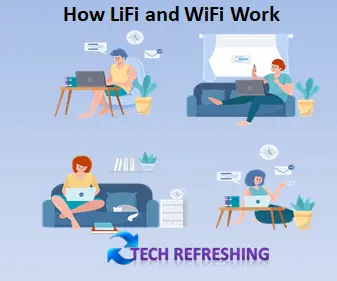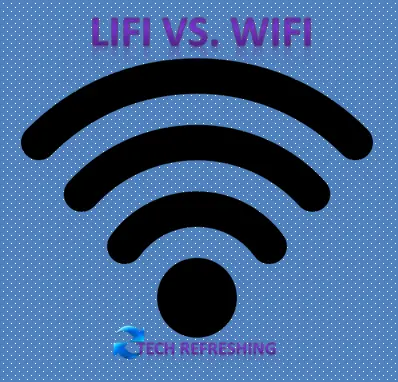Wireless technologies are crucial in modern life, enabling wireless internet connectivity and communication. WiFi has been the primary wireless technology for many years but LiFi ( Light Fidelity) has emerged as a potential alternative. This Blogpost will compare these two technologies and examine their respective advantages and disadvantages.
LiFi is a wireless communication technology that employs light to transfer data, whereas WiFi utilizes radio waves. LiFi operates by altering the light from an LED (or any other light source) at a very high frequency, which is subsequently obtained and analyzed by a photodetector. Although it is still a recent innovation and hasn’t been widely adopted yet, LiFi can offer quicker and more secure data transmission than WiFi, particularly in high-density settings.
On the other hand, WiFi is a proven wireless technology that has been in use since the late 1990s. It now rules wireless internet connectivity and uses radio waves to deliver data between devices. Compared to LiFi, WiFi offers the advantage of better coverage, a longer range and device compatibility.
The importance of wireless technologies in modern life cannot be overstated. From smartphones to laptops to smart home devices, wireless connectivity is critical to many aspects of daily life. As the demand for faster, more reliable wireless connectivity grows, it’s important to explore the potential of emerging technologies like LiFi and compare them to established technologies like WiFi.
This blog post aims to present a comprehensive evaluation of LiFi and WiFi, examining their respective technologies, advantages and limitations, and potential uses. After reading this post, readers will have a clearer comprehension of the contrasts between LiFi and WiFi, and be able to make more informed decisions on which technology to employ in various situations.
How LiFi and WiFi Work

LiFi and WiFi both use different types of waves to transmit data. LiFi uses light waves, while WiFi uses radio waves. In this section, we will explain how each technology works and compare the two.
How LiFi works
LiFi uses light waves to transmit data by modifying the intensity of the light waves to generate a binary code that signifies data. This technique is called Visible Light Communication (VLC). VLC leverages an LED or another light source to convey the data, which is subsequently received and deciphered by a photodetector. The data is later transformed into its original format, such as text, image or video.
LiFi makes use of light wavelengths like ultraviolet or infrared light that are invisible to the human eye. This indicates that the technology is unaffected by other visible light sources and can be used even in the dark.
How WiFi works
WiFi transmits data using radio waves. The process involves transforming data into radio waves, which are then sent through the air to a recipient. A router is employed by WiFi to disseminate the signal, and gadgets within its range can link to the network to get online access.
The ability of WiFi signals to pass through walls and other barriers makes it practical for broad areas such as public spaces, homes, and offices. Nonetheless, this also implies that WiFi signals can be intercepted effortlessly by illegitimate devices or individuals, exposing the technology to security risks.
Comparison of the two technologies

There are various distinctions and similarities between LiFi and WiFi. The key distinction between the two is the kind of waves that are employed to transfer data. It has a substantially greater frequency and data transfer rate than WiFi since LiFi employs light waves. Compared to the fastest WiFi standard, which can only carry data at speeds of up to 9.6 Gbps, LiFi can transmit data at rates up to 224 Gbps.
LiFi provides an additional advantage of enhanced security compared to WiFi. The technology leverages light waves that cannot penetrate walls or other obstacles, thus making it more challenging for unauthorized devices or individuals to eavesdrop on the data. Moreover, since LiFi necessitates a line-of-sight connection, hacking or interfering with the signal is more arduous.
Both LiFi and WiFi have distinct merits and demerits. The selection of which technology to apply is contingent on the individual needs of the user, such as speed, security, range, and compatibility. As technology progresses, it is probable that we will encounter more innovations and advancements in both LiFi and WiFi.
Advantages of LiFi over WiFi
While both LiFi and WiFi have their own unique advantages, LiFi has several benefits over WiFi that make it an attractive alternative in certain situations. In this section, we will explore the advantages of LiFi over WiFi.
Faster data transfer rates
LiFi’s primary advantage is its higher data transfer rates. LiFi can transmit data at speeds of up to 224 Gbps, which surpasses the fastest WiFi standard, with a maximum data transfer rate of 9.6 Gbps. This implies that LiFi is optimal for tasks necessitating high-speed data transfer, such as video streaming, transferring large files or transmitting significant amounts of data.
More secure data transmission
LiFi’s enhanced security is attributed to its use of light waves that cannot penetrate walls or other obstacles. As a result, it is more challenging for unauthorized devices or individuals to intercept the data. Moreover, LiFi necessitates a line-of-sight connection, making it harder to hack or interfere with the signal. Therefore, LiFi is a more secure choice for tasks requiring secure data transmission, such as in banking, healthcare or government applications.
Lower interference from other wireless signals
LiFi does not interfere with other wireless signals like Bluetooth, radio waves, or microwave radiation because it employs light waves as its primary mode of communication. Since there is less interference across various wireless technologies as a result, network performance as a whole may be enhanced. While other wireless signals can interfere with WiFi and impede network performance, the latter is also susceptible to such interference.
Better for use in high-density environments
In high-density environments like stadiums, airports or office buildings, LiFi is a better choice than WiFi. The signal strength of WiFi can be affected by the number of devices connected to the network since its signals can travel through walls and other obstacles. As a result, network performance can be slower and speed can be reduced. In contrast, LiFi uses light waves that do not travel through walls or other obstacles, so the signal is not affected by the number of devices connected to the network. As a result, LiFi can provide faster and more dependable connectivity in high-density environments.
LiFi offers faster data transfer rates, more secure data transmission, lower interference from other wireless signals and better performance in high-density environments compared to WiFi. Despite being a relatively new technology with limited adoption, LiFi shows potential for providing better data transmission in specific use cases. As technology progresses, further improvements in LiFi may make it a more viable alternative to WiFi.
Advantages of WiFi over LiFi
While LiFi has several advantages over WiFi, it also has some disadvantages that make WiFi a better option in certain situations. In this section, we will explore the advantages of WiFi over LiFi.
Longer range and better coverage
One of the main advantages of WiFi over LiFi is its longer range and better coverage. WiFi signals can travel through walls and other obstacles, which means that they can cover a wider area than LiFi. This makes WiFi a better option for applications that require connectivity over a larger area such as outdoor areas or multi-story buildings.
Established infrastructure and widespread availability
Another advantage of WiFi over LiFi is its established infrastructure and widespread availability. WiFi has been around for decades and is available in almost every public space, including coffee shops, airports and hotels. This means that users can easily access WiFi networks almost anywhere they go. In contrast, LiFi is a relatively new technology and is not yet widely available. It may take some time for LiFi to become more widely adopted and for infrastructure to be established.
Compatibility with existing devices
Compared to LiFi, WiFi is more compatible with existing devices as nearly every device, including smartphones, laptops and tablets, already have WiFi connectivity. Therefore, users don’t need to buy extra hardware to connect to a WiFi network. However, LiFi requires special hardware such as LED bulbs or transceivers to transmit and receive data, which means that users might need to purchase additional devices or upgrade their current hardware to use LiFi.
WiFi has some advantages over LiFi, such as longer range, better coverage, established infrastructure, widespread availability and compatibility with existing devices. However, LiFi has several unique advantages, such as faster data transfer rates, more secure data transmission, lower interference from other wireless signals and better performance in high-density environments. The choice between LiFi and WiFi depends on the specific needs of the user or application. As technology continues to advance, we may see more innovations and improvements in both LiFi and WiFi that make them even more appealing options for wireless connectivity.
Applications of LiFi and WiFi
LiFi and WiFi are both used in a variety of applications today, ranging from personal use to industrial settings. In this section, we will explore some of the current and potential applications of LiFi and WiFi.
Examples of where LiFi and WiFi are currently used
WiFi:-
WiFi is used in almost every public space today, including coffee shops, airports and hotels. It is also used in homes and offices for personal and professional use. Some specific applications of WiFi include:
- Internet connectivity for personal devices (e.g. smartphones, laptops, tablets)
- Smart home devices, such as thermostats and security systems
- Industrial automation, such as monitoring and control of machinery and equipment
- Healthcare, such as remote patient monitoring and telemedicine
LiFi:-
LiFi is a newer technology than WiFi, but it is still used in some applications today. Some specific applications of LiFi include:
- Indoor positioning systems, such as in museums or retail stores
- Traffic management and control systems, such as in smart cities
- Military applications, such as secure communication in submarines and planes
- Underwater communication and data transmission
Potential applications of LiFi and WiFi in the future
As technology continues to advance, both LiFi and WiFi have the potential to be used in new and innovative ways. Some potential applications of LiFi and WiFi in the future include:
WiFi:
- Internet of Things (IoT) devices, such as sensors and wearables
- Autonomous vehicles, such as cars and drones
- Augmented reality and virtual reality applications
- Smart cities, such as public transportation and infrastructure monitoring
LiFi:
- LiFi-enabled light fixtures in homes and offices for faster and more secure internet connectivity
- Wireless communication in aircrafts and other transportation systems
- Healthcare applications, such as remote patient monitoring and medical imaging
- Secure communication in sensitive environments, such as government and military settings
In conclusion, both LiFi and WiFi have a wide range of current and potential applications. WiFi is a more established technology with widespread availability and compatibility with existing devices, while LiFi offers faster and more secure data transmission in certain situations. As technology continues to evolve, we may see more innovations and improvements in both LiFi and WiFi that make them even more valuable and useful for wireless connectivity in various applications.
Limitations and Challenges of LiFi and WiFi
While both LiFi and WiFi offer many benefits, there are also some limitations and challenges that must be considered. In this section, we will explore some of the potential limitations of LiFi and WiFi and the challenges to their widespread adoption.
Potential limitations of LiFi
- Line-of-sight requirement: LiFi requires a direct line of sight between the transmitter and receiver, which can limit its use in certain environments. Obstacles such as walls, furniture, and people can interfere with the signal, making it less reliable.
- Light interference: LiFi signals can be affected by interference from both natural and artificial light sources, which can result in decreased signal quality and reliability. This can pose a challenge for using LiFi in settings with high levels of ambient light.
- Limited range: LiFi has a limited range compared to WiFi, which can make it less practical for certain applications. While it can be used effectively in small, confined spaces, it may not be ideal for larger areas.
Potential limitations of WiFi
- Congestion: As more and more devices use WiFi, the available bandwidth can become congested, leading to slower data transfer rates and decreased reliability. This is particularly true in high-density areas such as cities.
- Security flaws: Unauthorized users may be able to intercept WiFi signals, compromising the security of data being communicated. This is especially problematic in delicate industries like finance and healthcare.
- Power consumption: WiFi devices require a significant amount of power to transmit and receive data, which can drain battery life in mobile devices.
Challenges to widespread adoption of LiFi and WiFi
- Infrastructure: While WiFi is already widely available and established, LiFi infrastructure is still in its infancy. The cost and effort required to implement LiFi in existing infrastructure can be a barrier to its widespread adoption.
- Compatibility: LiFi and WiFi devices are not currently compatible with each other, which can limit their interoperability. This can make it difficult to use LiFi and WiFi in the same environment.
- Education and Awareness: Many people may not be familiar with LiFi, and there may be a lack of understanding about its potential applications and benefits. Similarly, many people may not be aware of the security vulnerabilities of WiFi and how to protect themselves from cyber threats.
Both LiFi and WiFi offer many benefits, there are also potential limitations and challenges to their adoption. LiFi’s line-of-sight requirement and limited range can make it less practical for certain applications, while WiFi’s congestion and security vulnerabilities can compromise its reliability and security. In addition, the lack of LiFi infrastructure, device compatibility, and education and awareness can be barriers to widespread adoption. Despite these challenges, both LiFi and WiFi have the potential to be valuable wireless technologies for various applications in the future.
Conclusion
In this blog post, we have explored the similarities and differences between LiFi and WiFi, including how they work, their advantages and limitations and their potential applications. In summary, LiFi uses modulated light to transmit data, while WiFi uses modulated radio waves. LiFi has faster data transfer rates, better security and lower interference, but is limited by its line-of-sight requirement and limited range. WiFi has longer range, established infrastructure, and compatibility with existing devices, but is limited by congestion and security vulnerabilities.
LiFi and WiFi serve different purposes in modern wireless communication. LiFi is advantageous in high-density environments with interference, while WiFi is more suitable for applications requiring longer range and broader coverage.
Both LiFi and WiFi are anticipated to continue to develop and get better in the future. Hybrid systems that combine the benefits of both technologies are already being developed and research is ongoing to find ways to get around each technology’s drawbacks.
In conclusion, both LiFi and WiFi are valuable wireless technologies with their own strengths and weaknesses. By understanding their similarities and differences, we can make informed decisions about which technology to use for various applications and be better prepared for the future of wireless communication.


